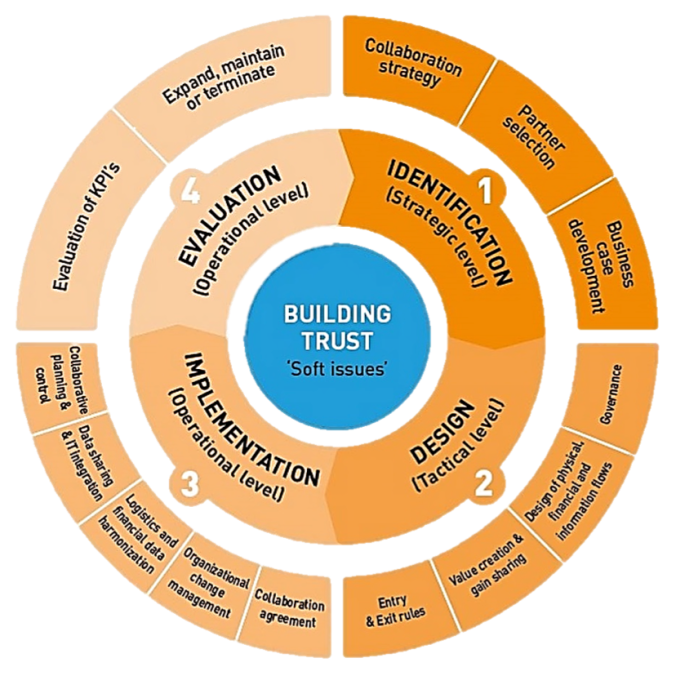In my previous blog I showed the benefits and disadvantages of control towers, which were:

Another way to indicate the benefits of control towers is by using “The house of benefits”, as shown in the figure blow. This model has three layers. The first layer is the foundation of profit, in which different cost and revenue drivers are involved. The second layer, the pillars of service, focusses on three of the in total four R’s. For more information about the four R’s, I have also written a blog about this subject, which you can find on my site. The last layer is the roof of benefits, which the organization will try to develop more and more. The human factor is a crucial element in the receiving of the benefits, because this requires changes and different approaches.

An important part of the human factor is cooperation, because the cooperation in projects determines the course of the project. There are three types of collaboration:
1. Team collaboration:
Group members are known, there is are clear task interdependencies, expected reciprocity, and explicit time-lines and goals. To achieve the goal, members must fulfil their interdependent tasks within the stated time.
2. Community collaboration:
There is a shared domain or area of interest, but the goal is more often focused on learning rather than on the tasks. People share and build knowledge rather than complete projects.
3. Network collaboration:
This type of collaboration is beyond the relationship-centric nature of team and community collaboration. It is collaboration that starts with individual action and self-interest, which then accrues to the network as individuals, contributing or seeking something from the network. Membership and time-lines are open and unbounded with no explicit roles.
I think that Team collaboration is already complex with a group of around five people with multiple projects and assignments. Because a correct performance of Team collaboration means that it will not occur that a project member misses the agreed deadlines, even though these deadlines are not the formal final deadlines. My opinion about the other types of collaborations is that these are rarer types, and on one way better to manage. Because the people in a network collaboration chose to be in this collaboration on their own and therefore the effort and commitment will, in my opinion, be better than team collaborations. Because the group members in team collaboration mostly have to work in groups and have mandatory assignments and deadlines.
A tool to make cooperation projects smoother and to see opportunities and threats in relation to solution, is the usage of the Dinalog collaboration wheel (Dinalog, 2017).

This wheel operates on strategic, tactical and operational level, and is divided in 4 steps, with a total of 14 sub steps:
1. Identification (strategic level)
1. Develop a collaboration strategy
A strategy to realize the objectives through supply chain collaboration. Including the expectations and the plans of achieving them.
2. Partner selection
Identify suitable partners for cooperation
3. Business case development
conduct a cost & benefits analysis and risk assessment at strategic level and to determine if a stable collaboration can be established.
2. Design (tactical level)
4. Governance
Determine coordination and control mechanisms to be put in place to manage the collaboration and its performance, including the most appropriate legal structure.
5. Design of physical, financial and information flows
Consider the best blue print to combine the physical, financial and/or information flows of the partners and what is required to synchronize the activities of the partners.
6. Value creation and gain sharing
Discover how much value is created through the collaboration and how the costs and benefits can be allocated fairly.
7. Entry and Exit Rules
Design entry rules for companies would like to join in the collaboration, and exit rules for companies would like to leave the collaboration
3. Implementation (operational level)
8. Collaboration agreement
Make an agreement among all the involved parties in the collaboration
9. Organizational change management
Manage the required organizational change in order to implement the design of cross chain collaboration in the operational processes.
10. Logistics and financial data harmonization
Formalize the definition and representation format of data elements used by partners, in order to eliminate redundancies and duplication in logistics and financial data.
11. Data sharing and IT alignment
Build up an inter-organizational information system (IOS) which enables enhanced information sharing and collaborative planning among partners.
12. Collaborative planning and control
Determine the inter-organizational decision-making procedure of daily planning activities and the coordination of interdependent tasks.
4. Evaluation
13. Evaluation of KPI’s
Develop an effective performance metric system to evaluate a cross chain collaboration
14. Expand, maintain or terminate
Determine whether to maintain, expand or terminate the collaboration in the end of the collaboration cycle, and organize an entry or exit that offers favourable outcomes to all parties.
Thank you all for reading this blog, which is my finishing blog of the course of Control Towers. I would like to thank Marcel Wouterse for sharing his knowledge and I hope everyone enjoyed reading my blogs and found them useful.
Kind regards,
Patrick Berghuis
Bibliography
Dinalog. (2017, juli 6). Cross chain collaboration center. Retrieved from conversion factory: collaboration tool voor succesvolle samenwerking: https://www.dinalog.nl/conversion-factory-collaboration-tool/
Lecture 8: 4C
Lecture 9: Human Factor & Trust